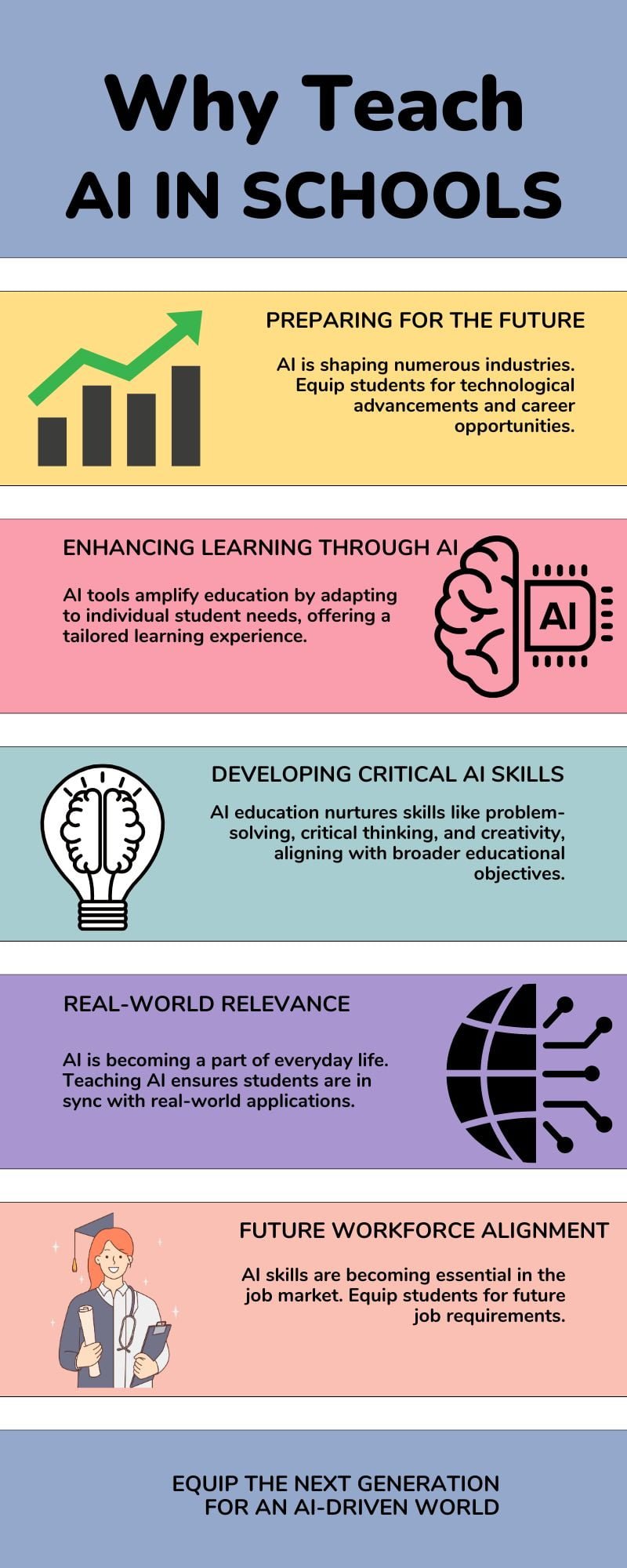Introduction: How to Teach AI in K-12 Schools
In today’s rapidly advancing world, understanding how to teach AI in K–12 schools is becoming a vital necessity. Artificial Intelligence (AI) is no longer confined to tech companies and research labs; it’s making its way into classrooms, shaping the future of education.
This guide will delve into the nuances of how to teach AI, emphasizing its importance, the skills required, and the resources available. Prepare to embark on a journey that will equip students with the knowledge and competencies needed for tomorrow’s AI-driven world.
Understanding AI Concepts
What is Artificial Intelligence?
Artificial intelligence, or AI, is the simulation of human intelligence by machines. Grasping how to teach AI starts with understanding these foundational ideas, as they form the bedrock of AI education.

Why is it Essential to Teach AI in Schools?
The question of how to teach AI in schools is pivotal for several reasons:
- Preparing for the Future: AI is shaping numerous industries. By teaching AI, students are readied for technological advancements and career opportunities.
- Enhancing Learning Through AI: It’s not just about how to teach AI; it’s about using AI tools to amplify education.
- Developing Critical AI Skills: AI education nurtures skills like problem-solving and critical thinking, aligning with broader educational objectives.

Resources and Guides on How to Teach AI
- STEMpedia’s Guide on Teaching AI: A detailed resource for understanding AI concepts and how to teach them.
- Intel’s Resources for Teaching AI: Intel provides tools and materials to help educators integrate AI into their classrooms.
By understanding what AI is and why it’s essential to teach it in schools, educators can begin to explore how to incorporate this exciting field into their curriculum. The next sections will delve into the practical aspects of teaching AI, from developing a curriculum to implementing it in the classroom.
Integrating AI into the Curriculum
Developing an AI Curriculum
When considering how to teach AI, creating a curriculum is paramount. Here’s how:
- Aligning with Existing Syllabus: Integrate AI concepts into subjects like mathematics, science, and computer programming. For example, teaching algorithms in math can be a precursor to more advanced AI topics.
- Focusing on Skills: Emphasize skills such as coding, data analysis, and logical thinking. Intel’s Teaching AI resources provide specific modules focusing on these competencies.
- Incorporating Project-Based Learning: Encourage students to work on real-world AI projects. This hands-on approach makes learning engaging and relevant.

Classroom Implementation
Successfully implementing AI education in the classroom involves:
- Creating an Engaging Learning Environment: Utilize interactive AI tools and create a space where students feel comfortable experimenting. The IDC Guide offers insights into using AI to foster an engaging educational space.
- Utilizing AI Tools in Teaching: Tools like AI-powered educational software can personalize learning, adapting to each student’s pace and needs. OSU’s AI Considerations for Teaching and Learning provides examples of how AI can be used to enhance teaching.
- Collaborating with Industry Experts: Partnerships with tech companies and local universities can provide additional resources and expertise. Intel, for instance, offers specific programs for educators to help in teaching AI.
Resources for Integrating AI
- PDF.co’s Blog on Teaching AI: Offers valuable insights on how to teach AI in schools effectively.
- Getting Smart’s Article on Teaching AI to All Students: Highlights inclusive strategies to ensure all students have access to AI education.
Integrating AI into the K–12 curriculum is a multifaceted process that requires thoughtful planning, collaboration, and the use of innovative tools. By aligning AI education with existing subjects, focusing on essential skills, and leveraging resources from industry experts, schools can create a dynamic and engaging AI learning experience for students.
Teaching Strategies and Challenges
Effective Methods on How to Teach AI
Teaching AI effectively requires innovative approaches that resonate with students. Here are some strategies:
- Hands-on Activities and Project-Based Learning: Encourage students to build AI models or work on real-world problems. For example, Intel’s resources include project-based learning modules that guide students through creating AI projects.
- Collaborative Learning: Foster collaboration by having students work in teams on AI projects. Insights from OSU’s AI Considerations for Teaching and Learning, which emphasize the significance of teamwork in AI education, support this strategy.
- Integrating AI Tools into Teaching: Use AI-powered educational software to personalize learning experiences. The IDC Guide provides examples of how AI can be used to enhance student engagement and understanding.
Challenges in How to Teach AI
Teaching AI in K–12 schools is not without challenges. Here are some common obstacles and ways to overcome them:
- Lack of Resources: Limited access to technology and expertise can hinder AI education. Collaborating with tech companies and universities, as suggested by Intel’s Teaching AI Resource, can provide the necessary support.
- Complexity of Concepts: AI can be complex, and breaking it down into digestible parts is crucial. The STEMpedia guide offers a step-by-step approach to teaching AI concepts.
- Ensuring Inclusivity: Making AI education accessible to all students, regardless of background, is a challenge. Getting Smart’s article emphasizes inclusive strategies to ensure that all students have the opportunity to learn about AI.
Teaching AI in K–12 schools necessitates a deep understanding of how to teach AI using innovative strategies and recognizing potential challenges. By incorporating hands-on activities, fostering collaborative learning, and leveraging resources from industry experts, educators can craft a comprehensive approach on how to teach AI, ensuring an engaging and effective learning experience.
Addressing challenges head-on ensures that teaching AI remains not only captivating but also inclusive and accessible to all students. The insights and examples from the provided resources serve as a roadmap for educators eager to embark on the enriching journey of teaching AI.
Case Studies and Resources
AI in the World: Innovative Approaches
C.L.Ai.R.A – A Community AI Assistant: Students in Winston-Salem worked with the first AI woman of color named C.L.Ai.R.A (Create Labs Artificial Intelligence Rendered Assistant). C.L.Ai.R.A’s purpose is to “help communities with their needs while representing people of color.” It’s a powerful example of AI being developed for community use.
Chatbots for Mental Health: During the COVID pandemic, chatbots were created to help with the mental health crisis among middle and high school students. Alison Darcy, a psychologist, created a chatbot to make mental healthcare services more accessible. A high school student who used the app reported positive effects from the experience.
AI for Personalized Learning: AI is enhancing personalized learning experiences. Tools like Quizizz create personalized learning paths based on student responses. Other examples include Knewton for higher education and Knowji, an audio-visual vocabulary app for language learners.
Can We All Teach About AI?
Rachelle Dené Poth, the author of the Getting Smart article, emphasizes that AI can be taught at all levels, regardless of a teacher’s experience. She shares her own journey of teaching AI in her eighth-grade STEAM Emerging Technology course:
“When I started, I did not know that much about AI at all. However, because I first wrote a blog about AI for Getting Smart, and dove into some research, it piqued my interest so much that I wanted to continue to learn more.”
She also highlights resources like AI4ALL, AI4K12, and Google AI Experiments, making it easier for any educator to start teaching AI.
Getting Started with AI Education
- Organizations and Resources: AIClub, AI4K12, DayofAI.org, and Google AI Experiments are some organizations that provide comprehensive resources for teaching AI.
- Virtual Summer Camps: Options like Code Connects, AICamp, and AIClub offer summer camps focusing on AI and data science for various age groups.
These case studies and resources illuminate the innovative methods on how to teach AI and its utilization in schools. From community-driven AI projects to mental health support and personalized learning tools, the examples provide a deep understanding of how to teach AI effectively and the vast possibilities of AI in education.
The shared experiences and available resources empower educators to integrate how to teach AI in their classrooms, nurturing creativity, critical thinking, and real-world problem-solving skills among students. The future of teaching AI in education is promising, and these examples serve as a beacon for more educators eager to embark on this transformative journey.
Conclusion
Teaching AI in K–12 schools is more than just a trend; it’s a necessity. This guide has provided insights into how to teach AI effectively, from understanding its basics to integrating it into the curriculum.
The journey of teaching AI is not without challenges, but the resources, insights, and examples shared in this guide provide valuable support. Collaboration with industry experts, the utilization of innovative tools, and a focus on hands-on, student-centered learning can make AI education a transformative experience.
As Mark Cuban aptly stated, “AI will dominate the workplace, and to be successful, people are going to have to understand it.” Educators have the opportunity and responsibility to equip young minds with the knowledge, skills, and creativity to thrive in a world where AI is a significant part of everyday life.
Whether you’re an experienced tech educator or just starting to explore AI, this guide offers actionable steps to bring AI into the classroom. Embrace the adventure, learn alongside your students, and be part of shaping a future where AI is not just understood but harnessed for positive impact. The future is here, and it’s time to teach AI to the next generation.









Recent Comments